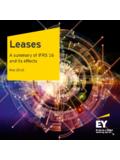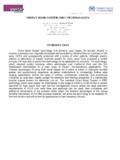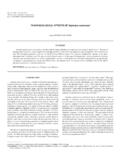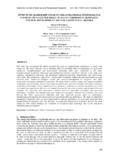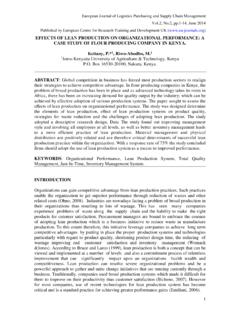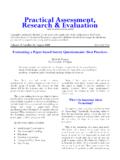Transcription of Automaticity of Social Behavior: Direct Effects of …
1 Journal of Personality and Social Psychology1996. Vol. 71, No. 2. 230-244 Copyright 1996 by the American Psychological Association, of Social behavior : Direct Effects of Trait Constructand Stereotype Activation on ActionJohn A. Bargh, Mark Chen, and Lara BurrowsNew York UniversityPrevious research has shown that trait concepts and stereotypes become active automatically in thepresence of relevant behavior or stereotyped-group features. Through the use of the same primingprocedures as in previous impression formation research, Experiment 1 showed that participantswhose concept of rudeness was primed interrupted the experimenter more quickly and frequentlythan did participants primed with polite-related stimuli. In Experiment 2, participants for whom anelderly stereotype was primed walked more slowly down the hallway when leaving the experimentthan did control participants, consistent with the content of that stereotype.
2 In Experiment 3, par-ticipants for whom the African American stereotype was primed subliminally reacted with morehostility to a vexatious request of the experimenter. Implications of this automatic behavior primingeffect for self-fulfilling prophecies are discussed, as is whether Social behavior is necessarily mediatedby conscious choice many years, Social psychologists have studied the effectsof priming on the individual's subsequent impressions of oth-ers. Priming refers to the incidental activation of knowledgestructures, such as trait concepts and stereotypes, by the currentsituational context. Many studies have shown that the recentuse of a trait construct or stereotype, even in an earlier or unre-lated situation, carries over for a time to exert an unintended,passive influence on the interpretation of behavior (see Bargh,1994;Higgins, 1989; Wyer&Srull, 1989, for reviews).
3 We argue here that such passive, automatic Effects of primingneed not be limited to Social perception. Recent research hasshown that attitudes and other affective reactions can be trig-gered automatically by the mere presence of relevant objectsand events, so that evaluation and emotion join perception inthe realm of Direct , unmediated psychological Effects of the en-vironment (see Bargh, 1994, in press, for reviews). But assum-ing that behavioral responses to situations are also representedmentally, as are stereotypes and attitudes, they should also becapable of becoming automatically activated, by the same prin-ciples that govern the development of Automaticity of A. Bargh, Mark Chen, and Lara Burrows, Department of Psy-chology, New York research was supported in part by Grant SBR-9409448 from theNational Science Foundation to John A.
4 Bargh and by a Max PlanckSociety (Germany) Research Prize to John A. Bargh and Peter Goll-witzer. The contributions of Elliott Rosenthal, Gayatri Taneja, andJayme Yocum to this research in their capacity as experimenters isgratefully acknowledged. We also thank Peter Gollwitzer, John Skow-ronski, Dan Wegner, and especially Leonard Berkowitz and Dan Gilbertfor their comments and suggestions concerning an earlier version of concerning this article should be addressed to JohnA. Bargh, Department of Psychology, New York University, 6 Washing-ton Place, Seventh Floor, New York, New York 10003. Electronic mailmay be sent via the Internet to in Attitudes and Social CognitionThe extent to which one's own thought and behavior are orare not under one's own intentional control is a fundamentalexistential question (see Posner & Snyder, 1975; Uleman &Bargh, 1989).
5 Indeed, over the past two decades, researchers inthe area of attitudes and Social cognition have documented thatmany of the phenomena they study are unintentional or auto-matic in nature (for reviews, see Bargh, 1994; Smith, 1994, inpress; Wegner & Bargh, in press). Attitudes are discovered tobecome activated automatically on the mere presence of the at-titude object, without conscious intention or awareness ( ,preconsciously; see Bargh, 1989), to then exert their influenceon thought and behavior (Bargh, Chaiken, Govender, & Pratto,1992; Bargh, Chaiken, Raymond, & Hymes, 1996; Fazio, San-bonmatsu, Powell, & Kardes, 1986). The self-concept (Bargh,1982; Bargh & Tota, 1988; Higgins, 1987; Strauman & Higgins,1987) is shown to become active automatically on the presenceof self-relevant stimuli to affect self-perception and become active automatically on the mere presenceof physical features associated with the stereotyped group(Brewer, 1988;Devine, 1989; Perdue &Gurtman, 1990; Pratto& Bargh, 1991), and categorizing behavior in terms of person-ality traits ( , Carlston & Skowronski, 1994; Winter & Ule-man, 1984) and then making dispositional attributions aboutthe actor's personality ( , Gilbert, 1989.)
6 Gilbert, Pelham, &Krull, 1988) have both been shown to occur automatically tosome growing evidence of Automaticity in Social psychologicalphenomena notwithstanding, it remains widely assumed thatbehavioral responses to the Social environment are under con-scious control (see review in Bargh, 1989). These responsesmight well be consciously chosen on the basis of automaticallyproduced perceptions and feelings (especially when the individ-ual was not aware of the potential for any such nonconsciousinfluence; see Herr, 1986, and Neuberg, 1988), but the ultimatebehavioral decisions themselves are believed to be made con-230 AUTOMATIC Social BEHAVIOR231sciously. Devine (1989), for example, argued for a two-stagemodel of prejudice in which the perceptual phase is automatic( , activation of stereotypes by the target person's features),whereas the second phase of prejudiced behavior is a matter ofconscious choice, driven by one's relevant values.
7 Fiske (1989)argued that a person could "make the hard choice" and over-come stereotypic influences on behavior if sufficiently moti-vated to do , the traditional rationale for the study of attitudes andsocial cognition is the belief (even faith) that choices of socialbehavior are based on the outcome of these processes thus, itis Social behavior that is the long-term focus of this research( , "thinking is for doing"; Fiske, 1992). The historic purposeof attitude research has been that attitudes predicted behavior ,and evidence to the contrary ( , LaPiere, 1934; Wicker, 1969)was cause for alarm, similar to the purpose of personality re-search ( , Mischel, 1968).The impetus behind Automaticity research is no into the Automaticity of attitudes was first conductedbecause it was hypothesized that attitudes that became activeautomatically (preconsciously) in the presence of the attitudeobject would be more likely to influence behavior toward theobject than those that depended on intentional conscious re-trieval of the attitude (Fazio et al, 1986).
8 The presumption be-hind studies of automatic influences in Social perception, suchas via primed or chronically accessible trait constructs ( ,Bargh & Pietromonaeo, 1982; Bargh & Thein, 1985), was thatsuch preconscious influences would play a stronger than usualrole in subsequent behavior toward the target person, as the per-ceiver would not be aware of the interpretive bias and so couldnot correct for it (Bargh, 1989). In a similar fashion, researchinto the Automaticity of stereotyping has been motivated by alarger concern with the controllability of prejudicial behavior (Devine, 1989; Fiske, 1989).Focusing the research spotlight on attitudes and perceptionsas mediators of behavior , in the present view, has obscured thepossibility that behavior need not always be so mediated.
9 Al-though it is quite reasonable to assume that attitudes and socialperceptual processes exist in the service of guiding behavior , thisdoes not require the assumption that behavioral responses al-ways require such Case for Automatic Social BehaviorWe propose that Social behavior is often triggered automati-cally on the mere presence of relevant situational features; thisbehavior is unmediated by conscious perceptual or judgmentalprocesses. We turn next to a discussion of several lines of sup-port, both theoretical and empirical, for this Responses Can Be Associated WithSituational FeaturesSocial-behavioral responses are represented mentally just asare trait concepts and attitudes. Thus, they should be capableof becoming activated automatically on the mere presence ofrelevant features in the environment by the same principles thatproduce automatic trait categorization and automatic theorists have argued that behavioral responses areactivated immediately by the situational context.
10 Lewin's(1943) notion of the psychological situation considered it toconsist of the totality of the individual's immediate reactions tothe objective, external situation. Mischel (1973) further devel-oped this concept as part of his Social -cognitive model of per-sonality. He noted that an individual can have all sorts of im-mediate reactions to a person or event, not limited to cognitiveor perceptual ones but including (a) expectancies for what wasgoing to happen next in the situation; (b) subjective evaluationsof what was happening; (c) emotional reactions one has had inthat situation in the past; and, most important to the presentthesis, (d) the behavioral response patterns one has availablewithin the situation based on one's past experience (see alsoHiggins, 1987).

